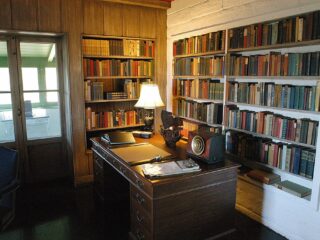by Peggy Jones
In the middle of a driving snowstorm in the winter of 1861, a ragtag bunch of prospectors arrived in Unionville, Nevada. They built a rough shelter into the side of the Humboldt Mountain and topped it with a canvas roof leaving an opening to allow for the escape of the smoking sagebrush they burned for warmth, when they could get it. It was an effective system, fueled by Indians hiking past the primitive structure laden with brush, which they generously shared.
The efficiency of the system was only called into question when a stray cow or mule would tumble through the opening meant for the escape of the smoke, mashing up the makeshift furniture of the prospectors and disturbing their dreams of instant wealth. One of these dreamers was Samuel Langhorne Clemens, later known as Mark Twain.
Mark Twain was not unduly fond of Unionville. According to the late local historian Peggy Trego, “he arrived expecting to find masses of silver lying all about on the ground and instead found himself on the business end of a shovel. Being allergic to shovels he left shortly thereafter.” Today, although many of the foundation stones have been removed and recycled into other structures, a sizeable rock marks the spot where Twain’s cabin once stood.
A more permanent testament to Twain’s stay in Unionville can be found in the pages of Roughing It (1872). Penned at the easeful distance afforded by his matrimonial home in Hartford, Connecticut, Twain remembers the last years of his bachelorhood during the harsh Northern Nevada winter replete with tumbling cows and generous Indians. The adventure began when Twain’s brother, Orion, was appointed Secretary to the Territorial Governor of Nevada as a reward for backing Lincoln in the presidential election of 1860. It ended when a forlorn Twain, his dreams of instant wealth dashed, joined the staff of the “Virginia City Enterprise” and began writing journalistic fiction in order to stave off starvation. If Twain had arrived in Unionville a few years later he probably still would not have attained instant riches but he would have discovered a more hospitable town, or at least a more populated one. In 1861, he found only “eleven cabins and a liberty pole” with six of the cabins strung along one side of a deep canyon and the other five facing them. A few years later he would have encountered nine saloons, hotels, stores, a church, a brewery, and a one room schoolhouse. At its height the population swelled to about 3000, many of whom were Chinese laborers. The Arizona Mine kept the town going for many years, in more ways than one. Because it was located 1000 feet above the town, the miners trudged uphill to work their 12-hour shifts for which they were paid three dollars a day.
Eventually the mine fizzled out, the school ran out of children, and Unionville was on its way to becoming a ghost town. However, unlike many of the defunct mining communities which dot Northern Nevada, it refuses to expire and has remained consistently, if sparsely, populated. Today, Unionville has reverted from a bustling mining community back to a place not unlike that seen by Twain over 130 years ago. Now there are no saloons, stores, or churches. The ruins of the one room schoolhouse still stands, as do the ruins of the Wells Fargo Bank, and the J.C. Fall Store.
Amid the ruins, hospitality is plentiful and warm at the Old Pioneer Garden Inn, owned and operated by Lew and Mitzi Jones for over twenty years. It is a tribute to their graciousness, and to Mitzi’s home cooking, that despite the remoteness of the town visitors return often enough to become part of an extended family. Many guests opt to stay in the Hadley House. Named after a pioneer family, it was completed in 1864 and has been lovingly restored. After many an exhausting day with the shovel, Mark Twain ate his supper in the older part of the house, which is now a library. Other guests prefer the Tack Room, where they can keep an eye on their horse in the adjoining stable. Still others choose the Field House with its view of a venerable, old waterwheel standing plum in the middle of Buena Vista Creek.
I am recently married and moved with my husband, David, to Unionville with hopes of developing my talents as a writer. Inspiration is as plentiful here as silver once was but one has to be willing to take up the shovel and dig. Living in an isolated area allows the eye to see against a stark background. It is possible to focus, not easily done, in more accessible areas. The night sky unfolds like an enormous blanket with the constellations painted on its surface in painstaking detail. I can’t walk down Unionville Road without thinking of the pioneers buried in the nearby cemetery with epitaphs like “killed by Indians.” These men and women walked down the same dirt road I do. It didn’t look much different back then, but now they are underneath and for the time being, I walk on the surface of the desert pathway. The same mountains towered over them and their ears delighted to the sound of the Buena Vista Creek, as do mine. The current 20 residents of Unionville are saddened that Mark Twain did not have a more enjoyable stay in our town but we are happy to have provided grist for his mill. We are proud that he walked among us.








